Comparison of Perfusion Culture Performance in Orbitally Shaken Bioreactors and Stirred Tank Bioreactors: A Spatiotemporal Dynamic Analysis of Shear Stress and Mass Transfer Based on Suspension Rheology
Abstract
:1. Introduction
2. Materials and Methods
2.1. Cell Culture
2.2. Cell and Metabolic Analysis
2.3. Rheology Measurements
2.4. CFD Simulation
2.4.1. Reactor Modelling and Grid Generation
2.4.2. CFD Simulation Setup
2.4.3. Quantitative Analysis of Mass Transfer and Shear
3. Results and Discussion
3.1. Cell Culture Results
3.2. Rheology of Cell Suspension
3.3. Impact of Rheology on Shear Stress and Mass Transfer in Bioreactors
3.3.1. Comparative Analysis of Gas–Liquid Phase Distribution
3.3.2. Fluid Velocity Distribution Under Rheological Variations
3.3.3. Analysis of Shear Stress Distribution and Evolution
3.3.4. Rheology-Dependent Changes in Mass Transfer Coefficients
3.3.5. Dynamic Evolution of Cellular Microenvironment and “Lifeline” Analysis via Euler–Lagrangian Tracking
4. Conclusions
Author Contributions
Funding
Data Availability Statement
Conflicts of Interest
Appendix A
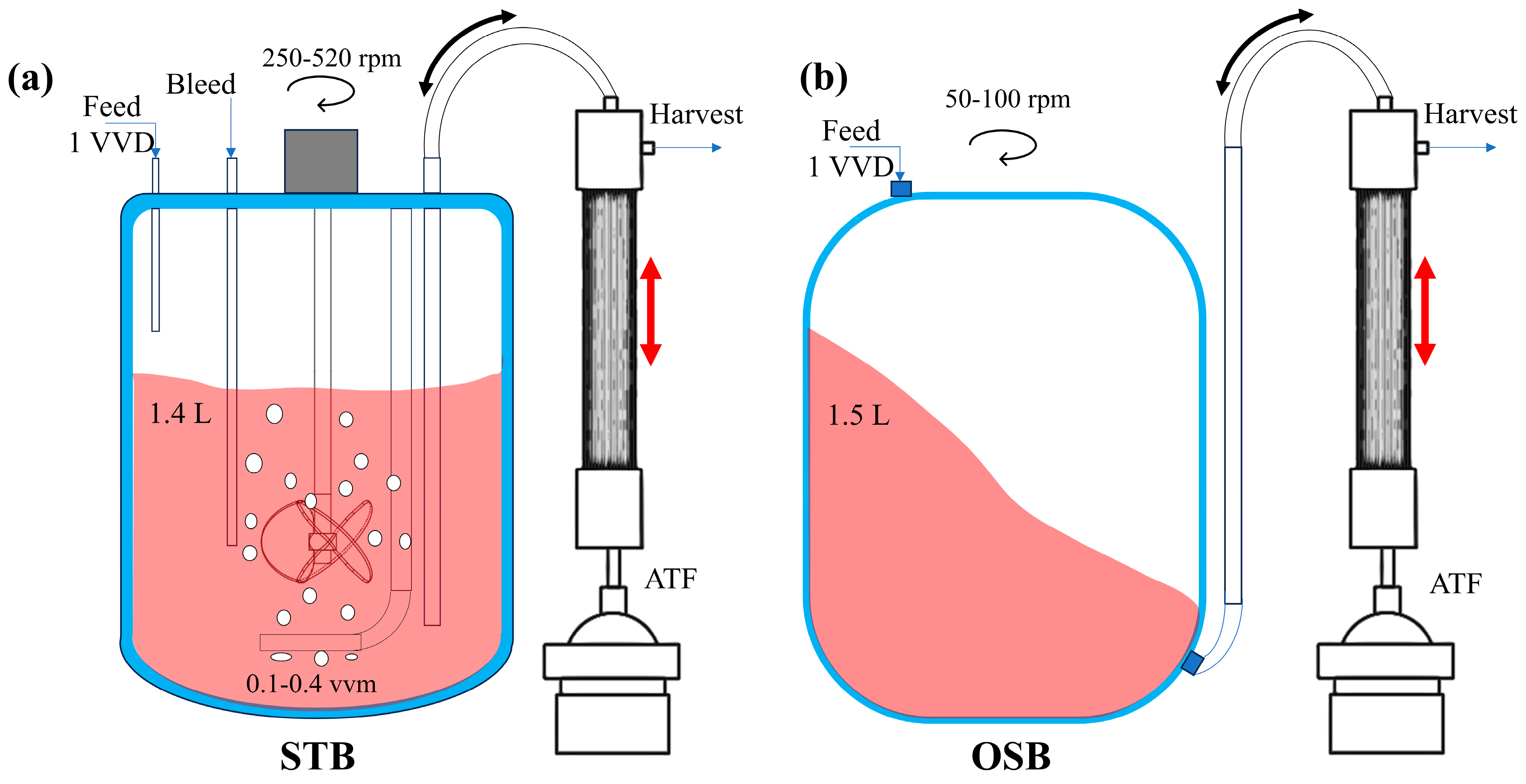

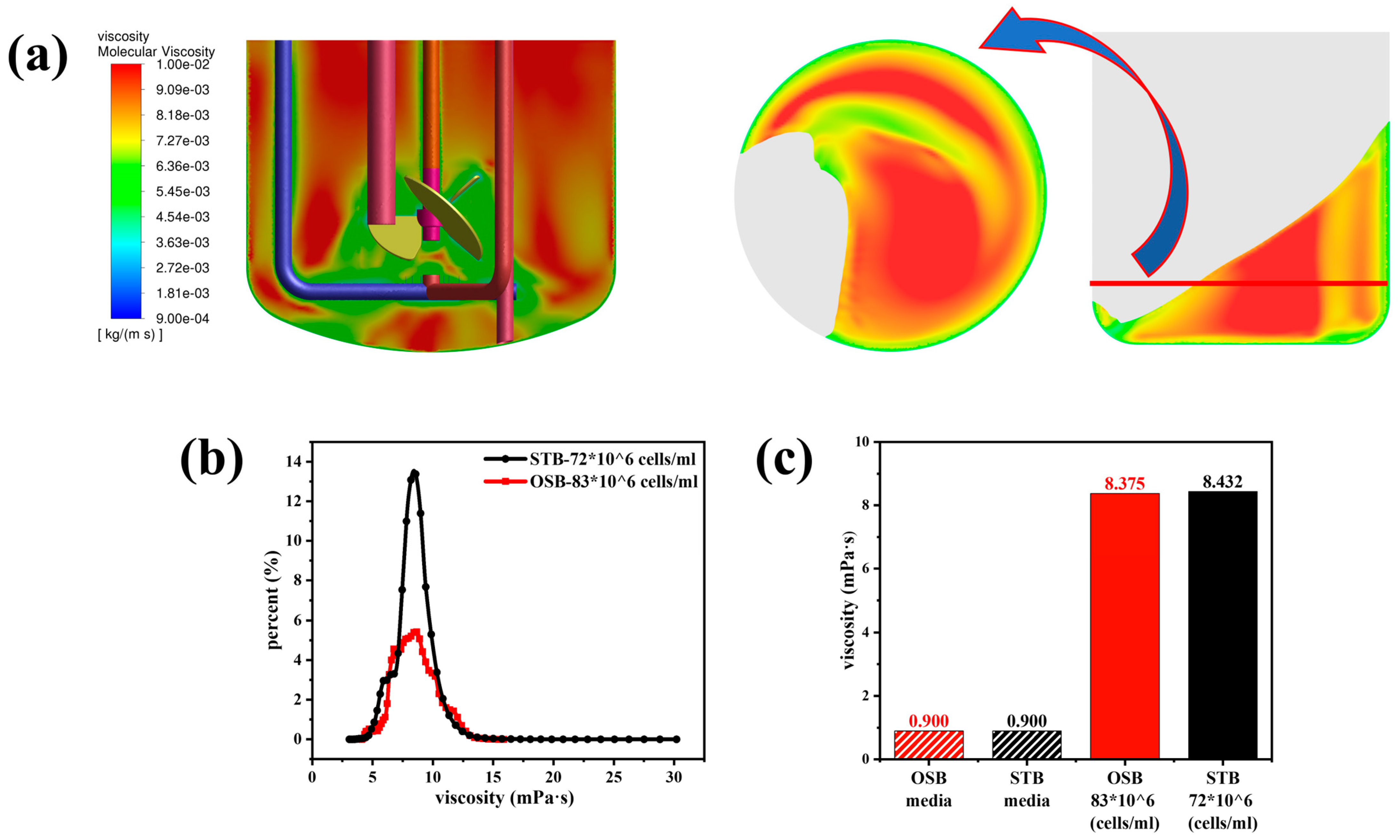
References
- Stone, C.A.; Spiller, B.W.; Smith, S.A. Engineering therapeutic monoclonal antibodies. J. Allergy Clin. Immunol. 2024, 153, 539–548. [Google Scholar] [CrossRef] [PubMed]
- Yang, O.; Prabhu, S.; Ierapetritou, M. Comparison between Batch and Continuous Monoclonal Antibody Production and Economic Analysis. Ind. Eng. Chem. Res. 2019, 58, 5851–5863. [Google Scholar] [CrossRef]
- Chotteau, V.; Schwarz, H.; Mäkinen, M. Continuous Bioprocessing for Upstream Process: Perfusion Process. In Biopharmaceutical Manufacturing: Progress, Trends and Challenges; Pörtner, R., Ed.; Springer International Publishing: Cham, Switzerland, 2023; pp. 113–158. [Google Scholar]
- Nöbel, M.; Barry, C.; MacDonald, M.A.; Baker, K.; Shave, E.; Mahler, S.; Munro, T.; Martínez, V.S.; Nielsen, L.K.; Marcellin, E. Harnessing metabolic plasticity in CHO cells for enhanced perfusion cultivation. Biotechnol. Bioeng. 2024, 121, 1370–1382. [Google Scholar] [CrossRef]
- Maria, S.; Bonneau, L.; Fould, B.; Ferry, G.; Boutin, J.A.; Cabanne, C.; Santarelli, X.; Joucla, G. Perfusion process for CHO cell producing monoclonal antibody: Comparison of methods to determine optimum cell specific perfusion rate. Biochem. Eng. J. 2023, 191, 108779. [Google Scholar] [CrossRef]
- Pörtner, R. Bioreactors for Mammalian Cells. In Animal Cell Culture; Al-Rubeai, M., Ed.; Springer: Cham, Switzerland, 2015; pp. 89–135. [Google Scholar]
- Klöckner, W.; Diederichs, S.; Büchs, J. Orbitally Shaken Single-Use Bioreactors. In Disposable Bioreactors II; Eibl, D., Eibl, R., Eds.; Springer: Berlin/Heidelberg, Germany, 2014; pp. 45–60. [Google Scholar]
- Wang, X.; Xu, J.; Guo, Q.; Li, Z.; Cao, J.; Fu, R.; Xu, M.; Zhao, X.; Wang, F.; Zhang, X.; et al. Improving product quality and productivity of an antibody-based biotherapeutic using inverted frustoconical shaking bioreactors. Front. Bioeng. Biotechnol. 2024, 12, 1352098. [Google Scholar] [CrossRef]
- Coronel, J.; Behrendt, I.; Bürgin, T.; Anderlei, T.; Sandig, V.; Reichl, U.; Genzel, Y. Influenza A virus production in a single-use orbital shaken bioreactor with ATF or TFF perfusion systems. Vaccine 2019, 37, 7011–7018. [Google Scholar] [CrossRef]
- Bürgin, T.; Coronel, J.; Hagens, G.; Keebler, M.V.; Genzel, Y.; Reichl, U.; Anderlei, T. Orbitally Shaken Single-Use Bioreactor for Animal Cell Cultivation: Fed-Batch and Perfusion Mode. In Animal Cell Biotechnology: Methods and Protocols; Pörtner, R., Ed.; Springer: New York, NY, USA, 2020; pp. 105–123. [Google Scholar]
- Zhang, X.; Stettler, M.; De Sanctis, D.; Perrone, M.; Parolini, N.; Discacciati, M.; De Jesus, M.; Hacker, D.; Quarteroni, A.; Wurm, F. Use of Orbital Shaken Disposable Bioreactors for Mammalian Cell Cultures from the Milliliter-Scale to the 1000-Liter Scale. In Disposable Bioreactors; Eibl, R., Eibl, D., Eds.; Springer: Berlin/Heidelberg, Germany, 2010; pp. 33–53. [Google Scholar]
- Ameenuddin, M.; Anand, M.; Massoudi, M. Effects of shear-dependent viscosity and hematocrit on blood flow. Appl. Math. Comput. 2019, 356, 299–311. [Google Scholar] [CrossRef]
- Maisonneuve, B.G.C.; Roux, D.C.D.; Thorn, P.; Cooper-White, J.J. Effects of Cell Density and Biomacromolecule Addition on the Flow Behavior of Concentrated Mesenchymal Cell Suspensions. Biomacromolecules 2013, 14, 4388–4397. [Google Scholar] [CrossRef]
- Zoro, B.J.H.; Owen, S.; Drake, R.A.L.; Mason, C.; Hoare, M. Regenerative medicine bioprocessing: Concentration and behavior of adherent cell suspensions and pastes. Biotechnol. Bioeng. 2009, 103, 1236–1247. [Google Scholar] [CrossRef]
- Gabelle, J.C.; Jourdier, E.; Licht, R.B.; Ben Chaabane, F.; Henaut, I.; Morchain, J.; Augier, F. Impact of rheology on the mass transfer coefficient during the growth phase of Trichoderma reesei in stirred bioreactors. Chem. Eng. Sci. 2012, 75, 408–417. [Google Scholar] [CrossRef]
- Wyma, A.; Martin-Alarcon, L.; Walsh, T.; Schmidt, T.A.; Gates, I.D.; Kallos, M.S. Non-Newtonian rheology in suspension cell cultures significantly impacts bioreactor shear stress quantification. Biotechnol. Bioeng. 2018, 115, 2101–2113. [Google Scholar] [CrossRef]
- Pérez-Rodriguez, S.; Reynoso-Cereceda, G.I.; Valdez-Cruz, N.A.; Trujillo-Roldán, M.A. A comprehensive comparison of mixing and mass transfer in shake flasks and their relationship with MAb productivity of CHO cells. Bioprocess Biosyst. Eng. 2022, 45, 1033–1045. [Google Scholar] [CrossRef] [PubMed]
- Sieck, J.B.; Cordes, T.; Budach, W.E.; Rhiel, M.H.; Suemeghy, Z.; Leist, C.; Villiger, T.K.; Morbidelli, M.; Soos, M. Development of a Scale-Down Model of hydrodynamic stress to study the performance of an industrial CHO cell line under simulated production scale bioreactor conditions. J. Biotechnol. 2013, 164, 41–49. [Google Scholar] [CrossRef] [PubMed]
- Zhu, L.; Liao, Y.; Chang, X.; Su, M.; Ou, Y.; Wu, S.; Wu, Z.; Yang, H.; Li, J.; Huang, H. A Comparative Study of the Performance of Orbitally Shaken Bioreactors (OSRs) and Stirred Tank Bioreactors (STRs). Processes 2024, 12, 2849. [Google Scholar] [CrossRef]
- Wang, Z.; Li, D.; Gao, Q.; Yang, Q.; Xiong, X.; Jiang, C.; Zhang, F. Study of the flow field of a new fishtail-type stirring impeller in a stirred tank. Chem. Eng. Process.-Process Intensif. 2023, 194, 109577. [Google Scholar] [CrossRef]
- Mishra, S.; Kumar, V.; Sarkar, J.; Rathore, A.S. CFD based mass transfer modeling of a single use bioreactor for production of monoclonal antibody biotherapeutics. Chem. Eng. J. 2021, 412, 128592. [Google Scholar] [CrossRef]
- Lara, A.R.; Galindo, E.; Ramírez, O.T.; Palomares, L.A. Living with heterogeneities in bioreactors. Mol. Biotechnol. 2006, 34, 355–381. [Google Scholar] [CrossRef]
- Villiger, T.K.; Neunstoecklin, B.; Karst, D.J.; Lucas, E.; Stettler, M.; Broly, H.; Morbidelli, M.; Soos, M. Experimental and CFD physical characterization of animal cell bioreactors: From micro- to production scale. Biochem. Eng. J. 2018, 131, 84–94. [Google Scholar] [CrossRef]
- Vickroy, B.; Lorenz, K.; Kelly, W. Modeling Shear Damage to Suspended CHO Cells during Cross-Flow Filtration. Biotechnol. Progr. 2007, 23, 194–199. [Google Scholar] [CrossRef]
- Zakrzewski, R.; Lee, K.; Lye, G.J. Development of a miniature bioreactor model to study the impact of pH and DOT fluctuations on CHO cell culture performance as a tool to understanding heterogeneity effects at large-scale. Biotechnol. Progr. 2022, 38, e3264. [Google Scholar] [CrossRef]
- Lapin, A.; Müller, D.; Reuss, M. Dynamic Behavior of Microbial Populations in Stirred Bioreactors Simulated with Euler−Lagrange Methods: Traveling along the Lifelines of Single Cells. Ind. Eng. Chem. Res. 2004, 43, 4647–4656. [Google Scholar] [CrossRef]
- Haringa, C.; Tang, W.; Deshmukh, A.T.; Xia, J.; Reuss, M.; Heijnen, J.J.; Mudde, R.F.; Noorman, H.J. Euler-Lagrange computational fluid dynamics for (bio)reactor scale down: An analysis of organism lifelines. Eng. Life Sci. 2016, 16, 652–663. [Google Scholar] [CrossRef] [PubMed]
- Zhang, W.; Ran, Q.; Zhao, L.; Wan, Y.; Ye, Q.; Tan, W.-S. Effective development of intensified perfusion culture based on shake tube semi-continuous bioreactors and optimal osmolarity constraint. Biochem. Eng. J. 2024, 206, 109309. [Google Scholar] [CrossRef]
- Zhu, L.; Monteil, D.T.; Wang, Y.; Song, B.; Hacker, D.L.; Wurm, M.J.; Li, X.; Wang, Z.; Wurm, F.M. Fluid dynamics of flow fields in a disposable 600-mL orbitally shaken bioreactor. Biochem. Eng. J. 2018, 129, 84–95. [Google Scholar] [CrossRef]
- Rahimzadeh, A.; Ein-Mozaffari, F.; Lohi, A. Analyzing of hydrodynamic stress and mass transfer requirements of a fermentation process carried out in a coaxial bioreactor: A scale-up study. Bioprocess Biosyst. Eng. 2024, 47, 633–649. [Google Scholar] [CrossRef]
- Grace, J.R.; Wairegi, T.; Nguyen, T.H. Shapes and Velocities of Single Drops and Bubbles Moving Freely Through Immiscible Liquids. Trans. Inst. Chem. Eng. 1976, 54, 167–173. [Google Scholar]
- Luo, H. Coalescence, Breakup and Liquid Circulation in Bubble Column Reactors; Technical University Library Of Norway: Trondheim, Norway, 1995. [Google Scholar]
- Laakkonen, M.; Moilanen, P.; Alopaeus, V.; Aittamaa, J. Modelling local bubble size distributions in agitated vessels. Chem. Eng. Sci. 2007, 62, 721–740. [Google Scholar] [CrossRef]
- Higbie, R.W.Z. The Rate of Absorption of a Pure Gas into a Still Liquid During Short Periods of Exposure. Trans. Am. Inst. Chem. Eng. 1934, 31, 365–389. [Google Scholar]
- Zhang, Z.; Thomas, C.R. Eddy Number Distribution in Isotropic Turbulence and Its Application for Estimating Mass Transfer Coefficients. Chem. Eng. Commun. 1995, 140, 207–217. [Google Scholar] [CrossRef]
- Walther, J.; McLarty, J.; Johnson, T. The effects of alternating tangential flow (ATF) residence time, hydrodynamic stress, and filtration flux on high-density perfusion cell culture. Biotechnol. Bioeng. 2019, 116, 320–332. [Google Scholar] [CrossRef]
- Zhang, W.; Ran, Q.; Zhao, L.; Ye, Q.; Tan, W.-S. Characterization of cellular responses and cell lysis to elevated hydrodynamic stress from benchtop perfusion bioreactors. Biotechnol. J. 2024, 19, 2400063. [Google Scholar] [CrossRef]
- Clincke, M.-F.; Mölleryd, C.; Zhang, Y.; Lindskog, E.; Walsh, K.; Chotteau, V. Very high density of CHO cells in perfusion by ATF or TFF in WAVE bioreactor™. Part I. Effect of the cell density on the process. Biotechnol. Prog. 2013, 29, 754–767. [Google Scholar] [CrossRef]
- Pan, X.; Dalm, C.; Wijffels, R.H.; Martens, D.E. Metabolic characterization of a CHO cell size increase phase in fed-batch cultures. Appl. Microbiol. Biotechnol. 2017, 101, 8101–8113. [Google Scholar] [CrossRef] [PubMed]
- Karst, D.J.; Steinhoff, R.F.; Kopp, M.R.G.; Serra, E.; Soos, M.; Zenobi, R.; Morbidelli, M. Intracellular CHO Cell Metabolite Profiling Reveals Steady-State Dependent Metabolic Fingerprints in Perfusion Culture. Biotechnol. Prog. 2017, 33, 879–890. [Google Scholar] [CrossRef]
- Papadopoulou, A.; Gillissen, J.J.; Wilson, H.J.; Tiwari, M.K.; Balabani, S. On the shear thinning of non-Brownian suspensions: Friction or adhesion? J. Non-Newton. Fluid Mech. 2020, 281, 104298. [Google Scholar] [CrossRef]
- Bui, A.V.; Nguyen, M.H. Prediction of viscosity of glucose and calcium chloride solutions. J. Food Eng. 2004, 62, 345–349. [Google Scholar] [CrossRef]
- Di Spirito, N.A.; Grizzuti, N.; Lutz-Bueno, V.; Urciuoli, G.; Auriemma, F.; Pasquino, R. Pluronic F68 Micelles as Carriers for an Anti-Inflammatory Drug: A Rheological and Scattering Investigation. Langmuir 2024, 40, 1544–1554. [Google Scholar] [CrossRef]
- Rahimzadeh, A.; Ein-Mozaffari, F.; Lohi, A. A Methodical Approach to Scaling Up an Aerated Coaxial Mixer Containing a Shear-Thinning Fluid: Effect of the Fluid Rheology. Ind. Eng. Chem. Res. 2023, 62, 8454–8476. [Google Scholar] [CrossRef]
- Godoy-Silva, R.; Mollet, M.; Chalmers, J.J. Evaluation of the effect of chronic hydrodynamical stresses on cultures of suspensed CHO-6E6 cells. Biotechnol. Bioeng. 2009, 102, 1119–1130. [Google Scholar] [CrossRef]
- Šrom, O.; Trávníková, V.; Wutz, J.; Kuschel, M.; Unsoeld, A.; Wucherpfennig, T.; Šoóš, M. Characterization of hydrodynamic stress in ambr250® bioreactor system and its impact on mammalian cell culture. Biochem. Eng. J. 2022, 177, 108240. [Google Scholar] [CrossRef]
- Rodriguez, G.; Micheletti, M.; Ducci, A. Macro- and micro-scale mixing in a shaken bioreactor for fluids of high viscosity. Chem. Eng. Res. Des. 2018, 132, 890–901. [Google Scholar] [CrossRef]
- Zheng, Z.; Wang, P.; He, N.; Si, Q.; Li, G.; Du, D.; Yuan, J. Effects of shear-thinning rheological properties on the energy loss characteristics of a biomass mixing vessel. Phys. Fluids 2023, 35, 073110. [Google Scholar] [CrossRef]
- Gao, Y.; Ray, S.; Dai, S.; Ivanov, A.R.; Abu-Absi, N.R.; Lewis, A.M.; Huang, Z.; Xing, Z.; Borys, M.C.; Li, Z.J.; et al. Combined metabolomics and proteomics reveals hypoxia as a cause of lower productivity on scale-up to a 5000-liter CHO bioprocess. Biotechnol. J. 2016, 11, 1190–1200. [Google Scholar] [CrossRef] [PubMed]
- Qian, Y.; Rehmann, M.S.; Qian, N.-X.; He, A.; Borys, M.C.; Kayne, P.S.; Li, Z.J. Hypoxia and transforming growth factor-beta1 pathway activation promote Chinese Hamster Ovary cell aggregation. Biotechnol. Bioeng. 2018, 115, 1051–1061. [Google Scholar] [CrossRef] [PubMed]
- Freiberger, F.; Budde, J.; Ateş, E.; Schlüter, M.; Pörtner, R.; Möller, J. New Insights from Locally Resolved Hydrodynamics in Stirred Cell Culture Reactors. Processes 2022, 10, 107. [Google Scholar] [CrossRef]
- Neuss, A.; Tomas Borges, J.S.; von Vegesack, N.; Büchs, J.; Magnus, J.B. Impact of hydromechanical stress on CHO cells’ metabolism and productivity: Insights from shake flask cultivations with online monitoring of the respiration activity. New Biotechnol. 2024, 84, 96–104. [Google Scholar] [CrossRef]
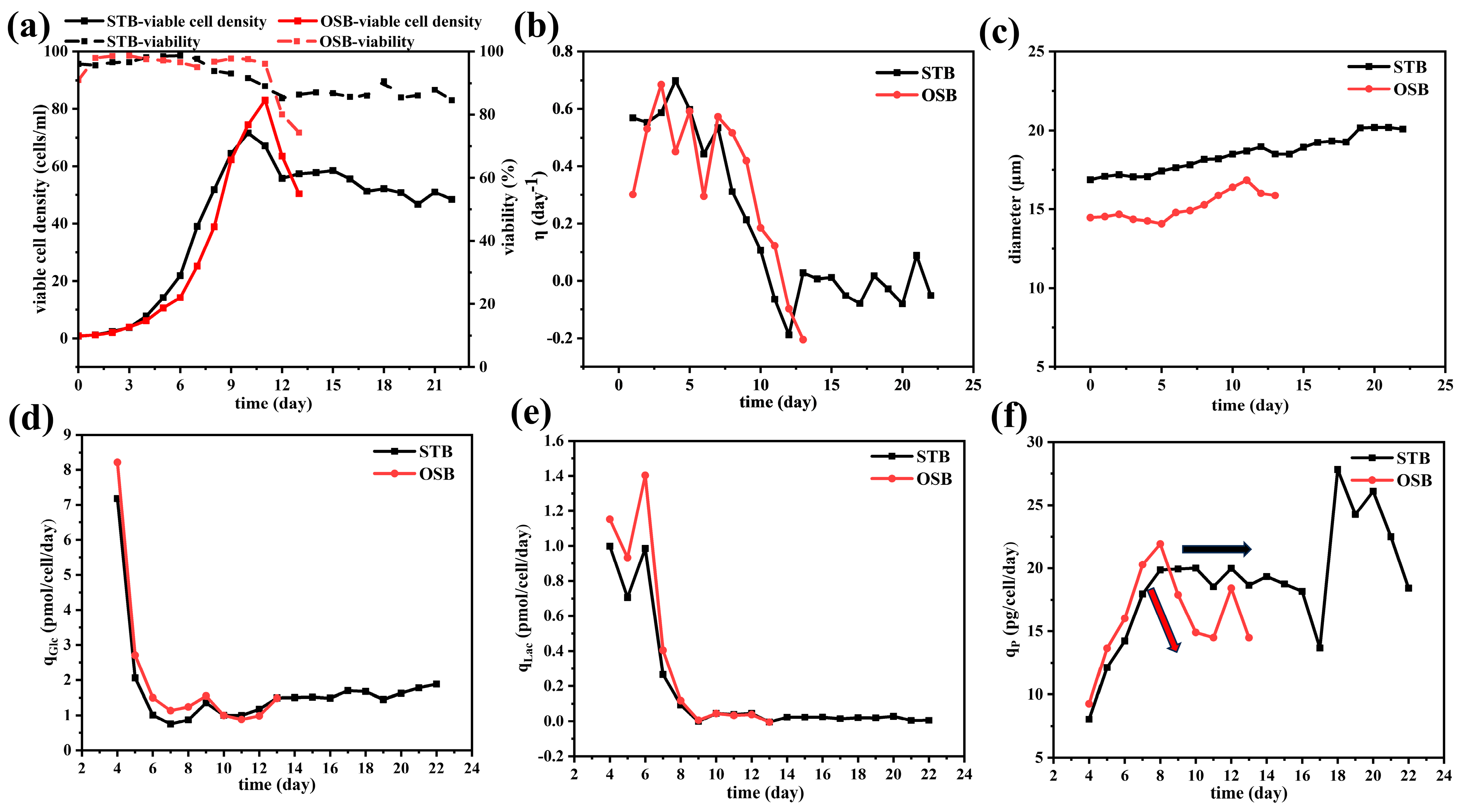
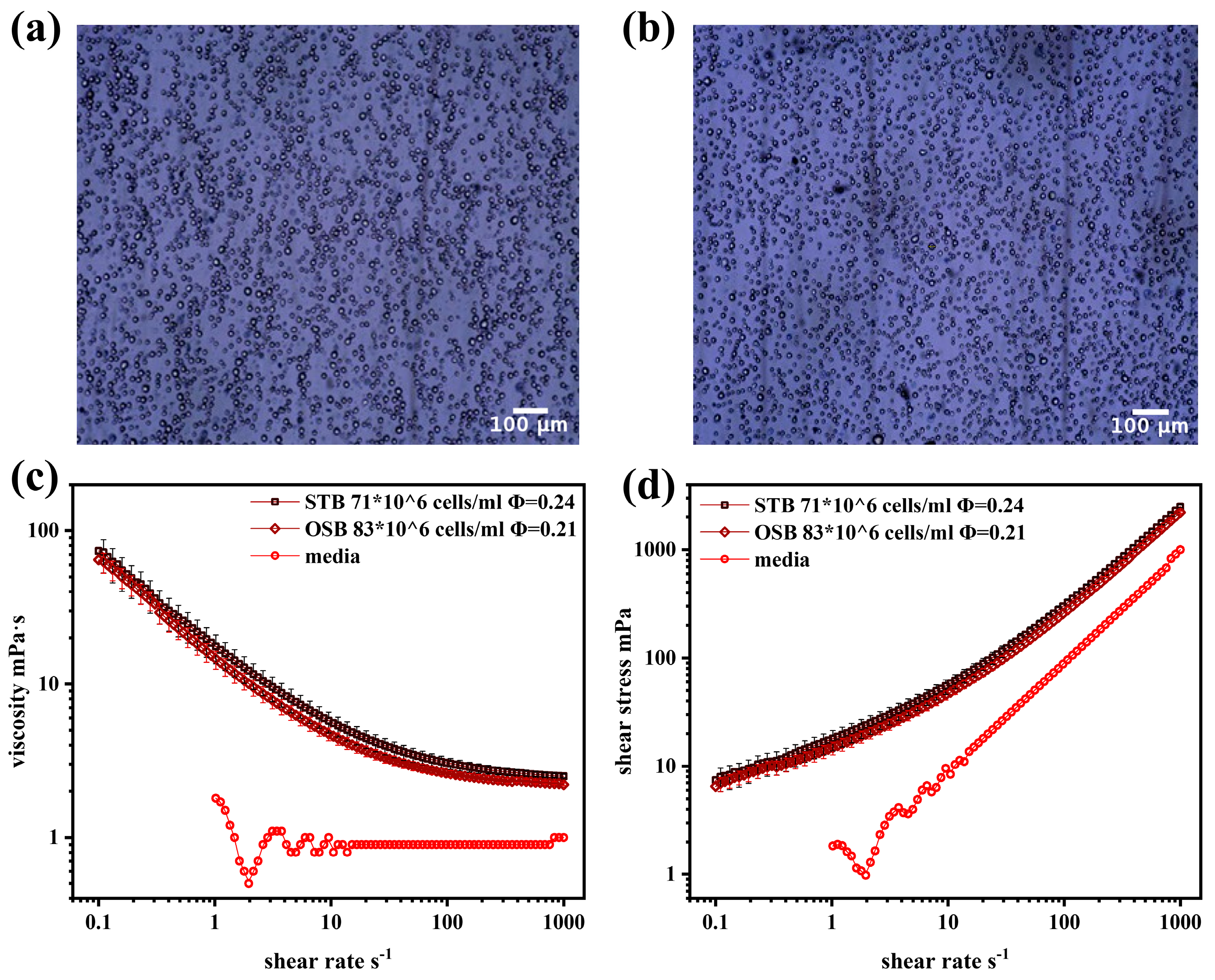
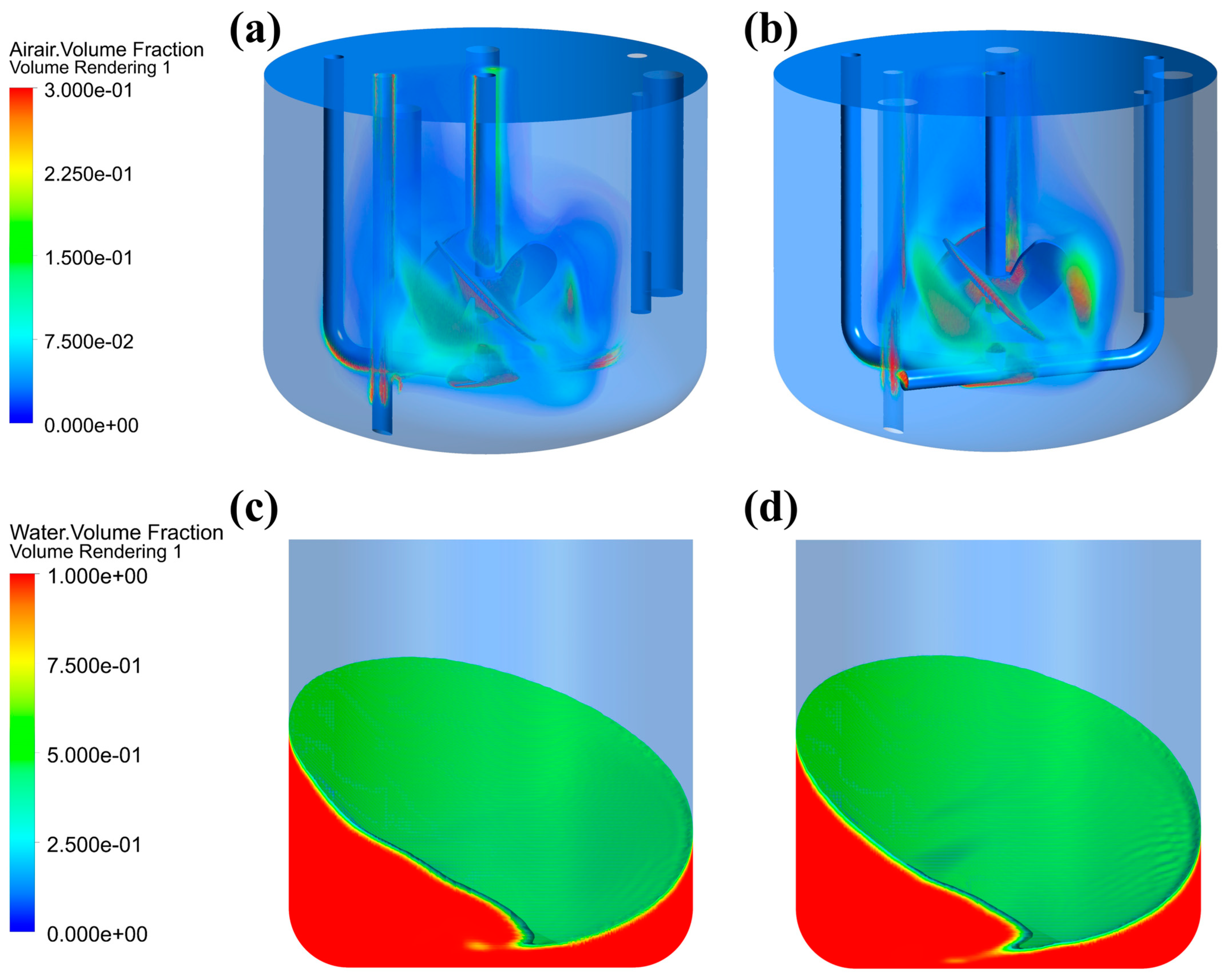
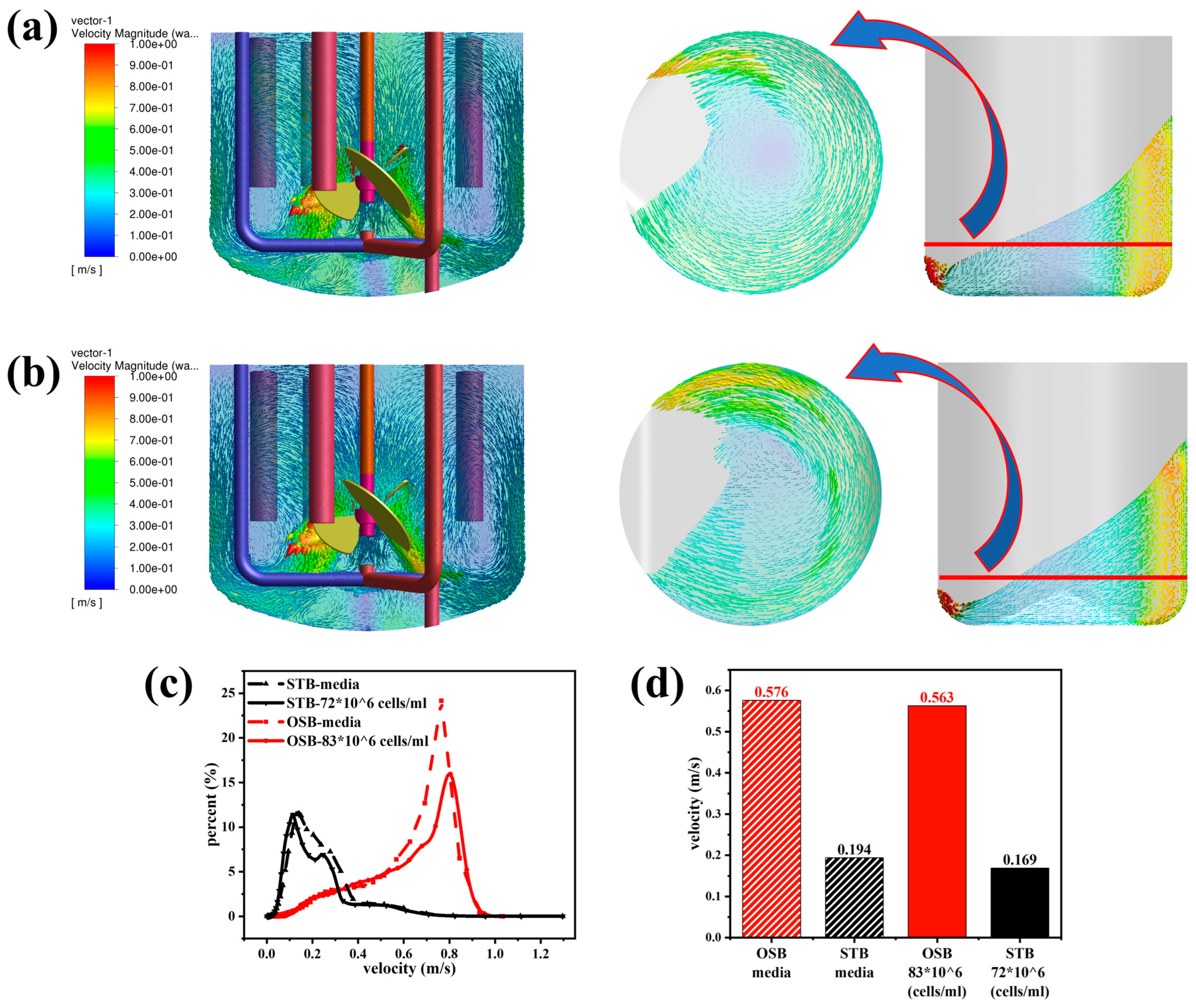


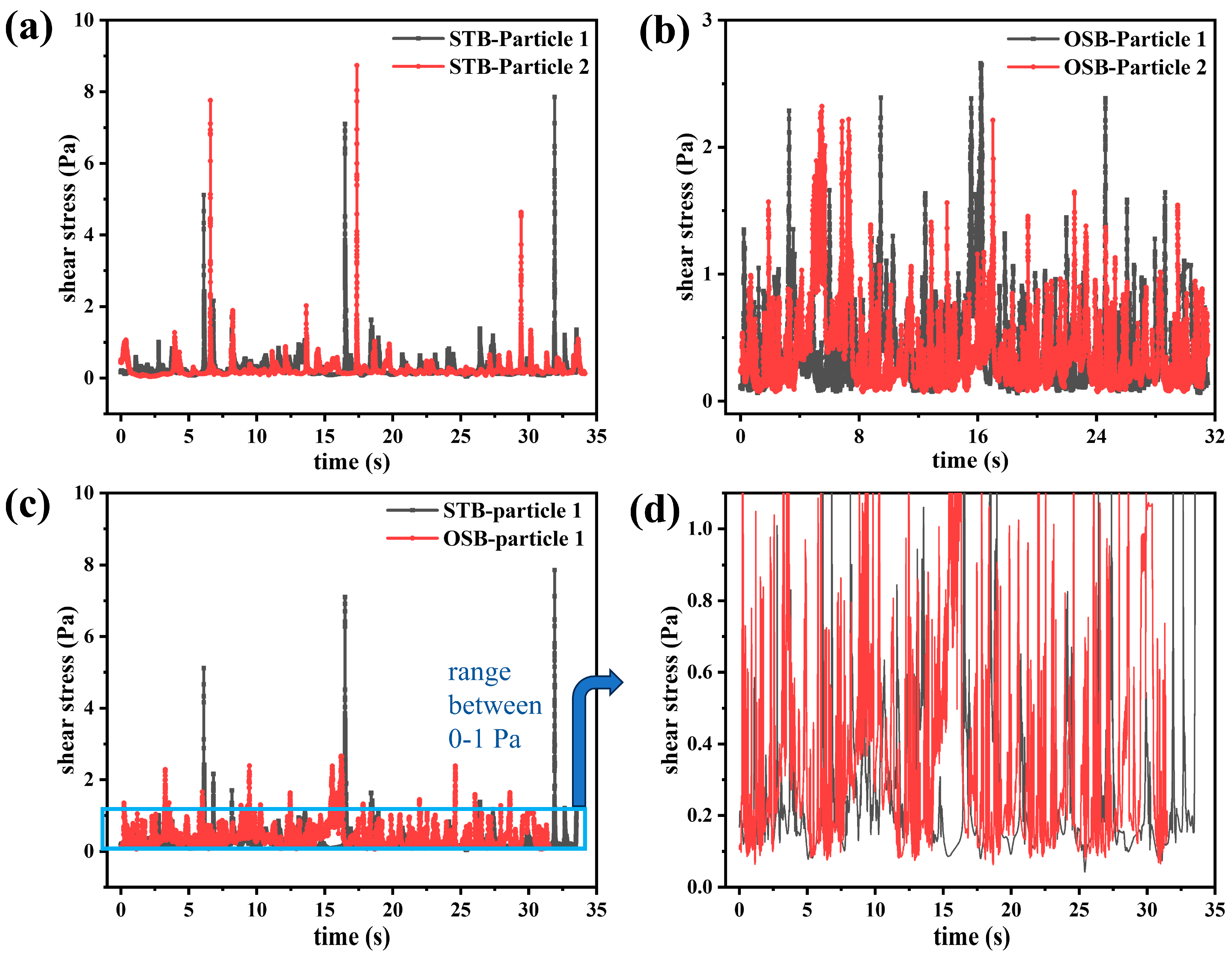
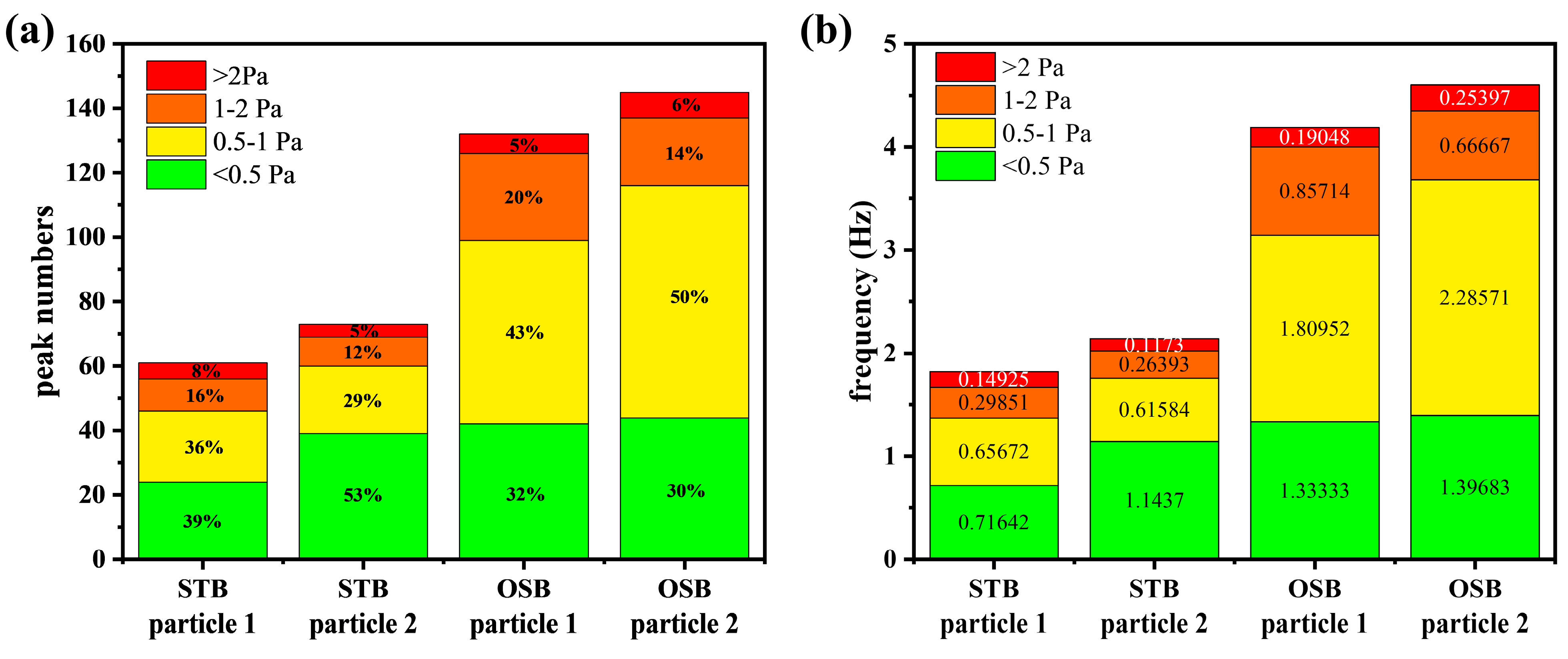
| Cell Density (Cells/mL) | Diameter (μm) | Φ (%) | μ∞ (mPa∗s) | Kcs (mPa∗s2-n) | n (-) |
|---|---|---|---|---|---|
| media | 0 | 0 | 0.9 | 0 | 0 |
| 71 ∗ 10^6 | 18.49 | 23.7 | 2.43 ± 0.24 | 15.31 ± 0.49 | 0. 321 ± 0.002 |
| 83 ∗ 10^6 | 16.85 | 20.8 | 2.2 ± 0.17 | 13.00 ± 0.53 | 0. 295 ± 0.003 |
Disclaimer/Publisher’s Note: The statements, opinions and data contained in all publications are solely those of the individual author(s) and contributor(s) and not of MDPI and/or the editor(s). MDPI and/or the editor(s) disclaim responsibility for any injury to people or property resulting from any ideas, methods, instructions or products referred to in the content. |
© 2025 by the authors. Licensee MDPI, Basel, Switzerland. This article is an open access article distributed under the terms and conditions of the Creative Commons Attribution (CC BY) license (https://creativecommons.org/licenses/by/4.0/).
Share and Cite
Zhang, B.; Ran, Q.; Dai, G.; Ye, Q.; Zhao, L.; Tan, W.-S. Comparison of Perfusion Culture Performance in Orbitally Shaken Bioreactors and Stirred Tank Bioreactors: A Spatiotemporal Dynamic Analysis of Shear Stress and Mass Transfer Based on Suspension Rheology. Processes 2025, 13, 955. https://doi.org/10.3390/pr13040955
Zhang B, Ran Q, Dai G, Ye Q, Zhao L, Tan W-S. Comparison of Perfusion Culture Performance in Orbitally Shaken Bioreactors and Stirred Tank Bioreactors: A Spatiotemporal Dynamic Analysis of Shear Stress and Mass Transfer Based on Suspension Rheology. Processes. 2025; 13(4):955. https://doi.org/10.3390/pr13040955
Chicago/Turabian StyleZhang, Botao, Qingyuan Ran, Gance Dai, Qian Ye, Liang Zhao, and Wen-Song Tan. 2025. "Comparison of Perfusion Culture Performance in Orbitally Shaken Bioreactors and Stirred Tank Bioreactors: A Spatiotemporal Dynamic Analysis of Shear Stress and Mass Transfer Based on Suspension Rheology" Processes 13, no. 4: 955. https://doi.org/10.3390/pr13040955
APA StyleZhang, B., Ran, Q., Dai, G., Ye, Q., Zhao, L., & Tan, W.-S. (2025). Comparison of Perfusion Culture Performance in Orbitally Shaken Bioreactors and Stirred Tank Bioreactors: A Spatiotemporal Dynamic Analysis of Shear Stress and Mass Transfer Based on Suspension Rheology. Processes, 13(4), 955. https://doi.org/10.3390/pr13040955







